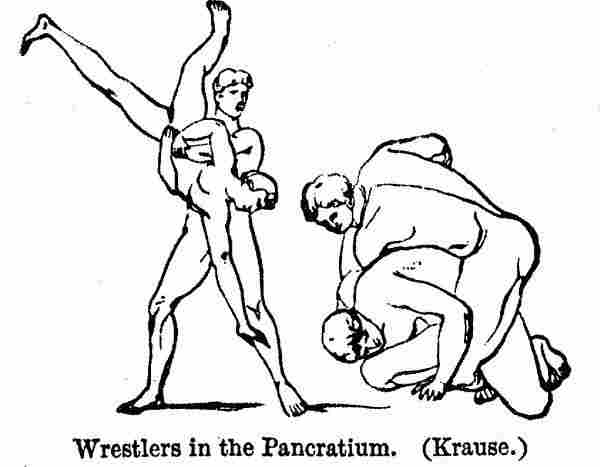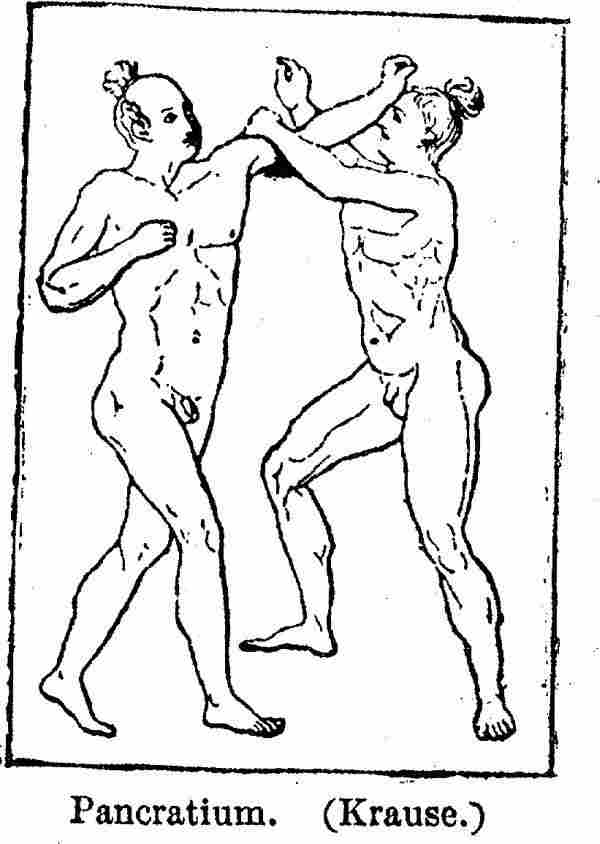.
PANCRA´TIUM (παγκράτιον) is composed of πᾶν and κράτος, and accordingly signifies an athletic game, in which all the powers of the fighter were called into action. The pancratium was one of the games or gymnastic contests which were exhibited at all the great festivals of Greece; it consisted of boxing and wrestling (πυγμὴ and πάλη: cf. Schol. on Plat. Rep, 338 C, D), and was reckoned to be one of the heavy or hard exercises (ἀγωνίσματα βαρέα or βαρύτερα), on account of the violent exertions and great weight of body it required, and for this reason it was not much practised in the gymnasia; and where it was practised, it was probably not without modifications to render it easier for the boys. According to the ancient physicians, it had very rarely a beneficial influence upon health (H. Mercurial. de Art. Gymnast. 5.7).
At Sparta the regular pancratium was forbidden, but the name was there applied to a fierce and irregular fight not controlled by any rules, in which even biting and scratching were not uncommon, and in which, in short, everything was allowed by which one of the parties might hope to overcome the other. In Homer we neither find the game nor the name of the pancratium mentioned; and as it was not introduced at the Olympic games until 01. 33=648 B.C. (Paus. 5.8.8), we may presume that the game, though it may have existed long before in a rude state, was not brought to any degree of perfection until a short time before that event. It is scarcely possible to speak of an inventor of the pancratium, as it must have gradually arisen out of a rude mode of fighting, which is customary among all uncivilised nations, and which was kept up at Sparta in its original state. But the Greeks regarded Theseus as the inventor of the pancratium, who for want of a sword was said to have used this mode of fighting against the Minotaurus (Schol. ad Pind. N. 5.49). Other legends represented Heracles as having been victor in the pancratium (Paus. 5.8.4), and later writers make other heroes also fight the pancratium (Lucan, Pharsal. 4.613, &c.); but these are mere fictions. After the pancratium was once introduced at Olympia, it soon made its way into the other great games of Greece also, and in the times of the Roman emperors we also find it practised in Italy. In 01. 145 = 200 B.C. the pancratium for boys was introduced at the Olympic games, and the first boy who gained the victory was Phaedimus, a native of a town in Troas (Paus. 5.8, in fin.). This innovation had been adopted before in others of the national games, e.g in the Nemean (Pind. Nem. v.); and in the 61st Pythiad (Ol. 108 = 348 B.C.) we find a Theban boy of the name of Iolaidas as victor in the pancratium at the Pythian games (Paus. 10.7.8). At the Isthmian games the pancratium for boys is only mentioned in the mythical age (Paus. 5.2, 4) till quite late times, but it may have been practised during the Greek classical period.
Philostratus (Imag. 2.6) says that the pancratium of men was the most beautiful of all athletic contests; and the combatants must certainly have shown to the spectators a variety of beautiful and exciting manœuvres, as all the arts of boxing and wrestling appeared here united (Aristot. Rh. 1.5; Plut. Sympos. 2.4, p. 638, 27).
The first person who is said to have fought the pancratium artistically was Leucaros of Acarnania (Schol. to Pind. N. 3.27). It was partly fought standing, partly was a rough and tumble on the ground (ἁλίνδησις, κύλισις). This twofold nature explains why the term παγκρατιάζειν is used somewhat variously, sometimes for simple boxing (τὸ παίειν ἀλλήλους ὀρθοστάδην, Lucian, Anach. 8); but the idea of violent combat seems to be generally associated with it (cf. Aeschin. Tim. § 26). Boxing was certainly considered the chief element (Lucian, Anach. 8, 24; Pind. N. 3.17; Schol. on Pind. Isthm. 4.75; Schol. on Dem. Mid. p. 537.71), where allusion is specially made to the blows received in the pancratium. The fact too that the “successors of Heracles” had to win their victory in wrestling (not boxing) and the pancratium tends to show that boxing must have been a principal part of the latter, for we cannot suppose it to have been disregarded. But still the ἁλίνδησις on the ground was a highly important feature of the pancratium. It is to be noticed that the fist does not appear to have been closed; the usual way to hold the hands was with the fingers curved (see the cuts). The caestus [CAESTUS] were not used, for Pausanias never mentions them in any of his accounts of the pancratium, nor are they found on any statues or pictures; further, Paus. 6.15, 3 seems to show that they were not used, for no wounds are anticipated from the pancratium: cf. Artemid. Oneir. 1.64, τὸ δὲ παγκράτιον τὰ αὐτὰ τῇ πυγμῇ σημαίνει πλὴν βλάβης. Nor were the lighter gloves called μειλίχαι used, for they would have impeded the movements of the fingers.
The name of these combatants was παγκρατιασταὶ or πάμμαχοι (Pollux, 3.150; cf. Plat. Euthyd. 271 D). Other predicates applied to the pancratium are ἄμαχος, ἄλειπτος, ἀήττητος, ἀπρόσμαχος, ἀσυνέξωστος, περισθενής, μεγαυχής: cf. Krause, Gymnastik und Agonistik, p. 536. The combatants fought naked, and had their bodies anointed and covered with sand, by [p. 2.329]which they were enabled to take hold of one another (Philostr. l.c.; Aristoph. Peace 897).
When two pancratiastae began their contest, they stood with outstretched arms: and the first object which each of them endeavoured to accomplish was to gain a favourable position and grip, each trying to make the other stand so that the sun might shine in his face, or that other inconveniences might prevent his fighting with success (cf. Gel. 13.27, § § 3, 4). This struggle was only the introduction to the real contest, though in certain cases this preparatory struggle might terminate the whole game, as one of the parties might wear out the other by a series of stratagems, and compel him to give up further resistance (ἀπαγορεύειν). Sostratus of Sicyon had gained many a victory by such tricks (Paus. 6.4.1). When the al contest began, each of the fighters might commence by boxing or by wrestling, accordingly as he thought he should be more successful in the one than in the other. The using the teeth and butting with the head were considered unfair fighting (κακομαχεῖν) and contrary to the law of the games (νόμος ἐναγώνιος): cf. Lucian, Demon. 49; Philostr. l.c. The victory was not decided until one of the parties was killed, or lifted up a finger, thereby declaring that he was unable to continue the contest either from pain or fatigue (Philostr. l.c.). It usually happened that one of the combatants, by some trick or other, made his antagonist fall to the ground, and the wrestling which then commenced was called ἀνακλινοπάλη, and continued until one of the parties declared himself conquered or was strangled, as was the case at Olympia with Arrhichion or Arrachion of Phigalia, in Ol. 54 (= 564 B.C.), who, however, was declared victor, as his opponent gave up at the last moment from the pain of a broken toe (Paus. 8.40.1, &c.; Euseb. Chron. p. 150, Scalig.). A lively description of this struggle is given by Philostratus (l.c.). Sometimes one of the fighters fell down on his back on purpose that he might thus ward off the attacks of his antagonist more easily, and this is perhaps the trick called ὑπτιασμός. The usual mode of making a person fall was to put one foot behind his, and then to push him backward, or to seize him round his body in such a manner that the upper part being the heavier the person lost his balance and fell. Hence the expression μέσον λαμβάνειν, μεσολαβεῖν, μέσον αἱρεῖν,

Wrestlers in the Pancratium. (Krause.)
τὰ μέσα ἔχειν, διὰ μηρῶν σπᾷν, &c. (Scalig. ad Euseb. Chron. p. 48). The above woodcut represents two pairs of pancratiastae; the one on the right hand is an example of the ἀνακλινοπάλη, and that on the left of the μεσολαβεῖν. They are taken from Krause's Gymnastik und Agonistik d. Hellen., Taf. xii. b, Fig. 35 b, 31 b, where they are copied respectively from Grivaud, Rec. d. Mon. Ant. vol. i. pl. 20, 21, and Krause, Signorum vet. icones, tab. 10.
As the contest was in a large measure wrestling, many of the tricks of wrestlers--ἀκροχειρισμός, ἄγχειν, λυγίζεν, στρεβλοῦν or στρέφειν--were often used. Violently to throw oneself on one's opponent (ἐνάλλεσθαι) was a common feature (cf. Pollux, l.c.; Philostr. l.c.). Many of the recognised figures and movements: of the pancratium were imitated in the gymnopaedic dance (Ath. 14.631). As an essential part of the pancratium was a struggle on the ground, and as regular battle with an enemy was a standing not a lying combat, Plato (Legg. 8.832 E, 834 A, B) banished the pancratium from his State, and substituted the contest of light-armed warriors (πελταστική).
The contests of pancratiastae at Olympia took place about mid-day: for in 472 B.C., beginning rather late, they continued on that occasion into the night (Paus. 6.24, 1: cf. 5.9, 3; 8.40, 3).
At Rome the pancratium is first mentioned in the games which Caligula gave to the people (D. C. 59.13, 9). After this time it seems: to have become extremely popular, and Justinian (Novell. 105.100.1, provided πάγκαρπον be, as some suppose, a mistake for παγκράτιον) made it one of the seven solemnities (πρόοδοι) which the consuls had to provide for the amusement of the people.
Several of the Greek pancratiastae have been immortalised in the epinician odes of Pindar, namely Timodemus of Athens (Nem. ii.), Melissus and Strepsiades of Thebes (Isth. iv. and vii.), Aristoclides, Phylacides and Cleander of Aegina (Nem. iii., Isth. v. and vi., viii.), and a boy Pytheas of Aegina (Nem. v.). But besides these the names of a great many other victors in the pancratium are known. (Compare Fellows, Discoveries in Lycia, p. 313, Lond. 1841.) A victor in both wrestling and the pancratium on the same day at Olympia was especially honoured, and considered to be the successor of Heracles. His name was regarded as worthy of being recorded for

Pancratium. (Krause.)
posterity. The first successor of Heracles (Paus. 5.8, 4) was Caprus of Elea, in 204 B.C. (ib. 5.21, 10, where a long list of similar victors in after-times is given). They appear to have been sometimes called παραδοξονῖκαι (Plut. Comp. Cim. et Lucull. 2), For a distinguished pancratiast to win a victory in one of the races was almost unheard of, the training required in either case being so [p. 2.330]very special (cf. Epictet. 3.1; Diod. 4.14), yet the pancratiast Theagenes won the long race at Phthia (Paus. 6.11, 5). Other celebrated pancratiastae were Polydamas (6.5, 4-8), Promachus, Timasitheus (6.8, 6-7), Clitomachus (6.15, 3-5), Ↄ,
The diet and training of the pancratiastae were the same as those of other athletae. [ATHLETAE] They generally wore their hair in a bunch (cirrus, Suet. Nero 45) on the top of the head; see the preceding cut taken from Krause (op. cit. Taf. xviii. Fig. 68).
(Compare Hieron. Mercurialis, de Arte Gymnastica; J. H. Krause, Die Gymnastik und Agonistik der Hellenen, vol. i. pp. 534-556; also in Pauly, 3.1019-1021, s. v. Gymnastica, sect. xiv.)
Dictionary of Greek and Roman Antiquities
| Ancient Greece
Science, Technology , Medicine , Warfare, , Biographies , Life , Cities/Places/Maps , Arts , Literature , Philosophy ,Olympics, Mythology , History , Images Medieval Greece / Byzantine Empire Science, Technology, Arts, , Warfare , Literature, Biographies, Icons, History Modern Greece Cities, Islands, Regions, Fauna/Flora ,Biographies , History , Warfare, Science/Technology, Literature, Music , Arts , Film/Actors , Sport , Fashion --- |


